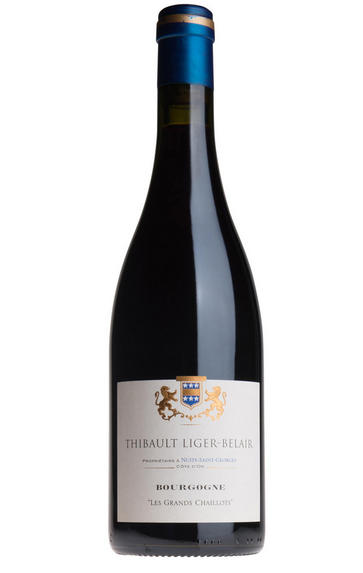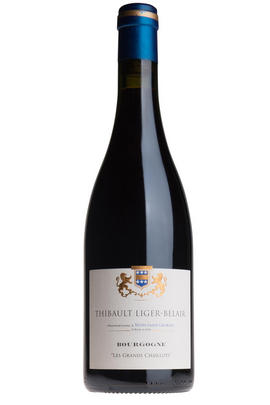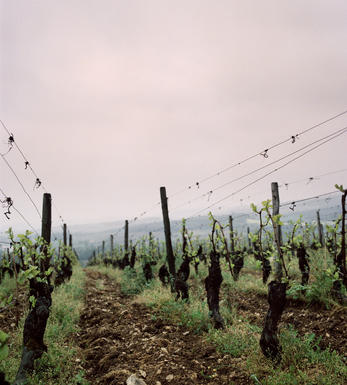
2016 Bourgogne Rouge, Les Grands Chaillots, Domaine Thibault Liger-Belair

Critics reviews
Stephen Tanzer, Vinous (winter 2019)
William Kelley - 30/04/2019
About this WINE

Domaine Thibault Liger-Belair
Domaine Thibault Liger-Belair is part of our Spotlight on sustainability series. You can view the full range here.
Thibault Liger-Belair is cousin to Vicomte Liger Belair of Vosne Romanée. In 2001 he took over an old family property in Nuits St Georges, taking back the vines which had been contracted out to various share croppers, and leased a cuverie just down the road. The family jewels (his branch) consist of Richebourg, Clos de Vougeot and Nuits St Georges Les St Georges, to which he has added further vineyards and a few additional cuvées made from purchased grapes.The vines are now certified organic and farmed biodynamically, with horses used to plough the vineyards where possible. The grapes are rigorously sorted on a table de tri, then destalked and fermented without much punching down or pumping over. They will be racked once during the elevage, but Thibault is not afraid of reductive flavours at this stage which, he feels, adds to the eventual substance and complexity of the wine. The oak regime is not to exceed 50% new barrels but also not to use any barrels more than three years old. The natural style of Thibault’s wines is plump and full-bodied, though the benefits of his farming methods seem to be bringing a more mineral aspect to the fruit as well.
The natural style of Thibault’s wines is plump and full-bodied, though the benefits of his farming methods seem to be bringing a more mineral aspect to the fruit as well.

Bourgogne Rouge
Bourgogne Rouge is the term used to apply to red wines from Burgundy that fall under the generic Bourgogne AOC, which can be produced by over 350 individual villages across the region. As with Bourgogne Blanc and Bourgogne Rosé, this is a very general appellation and thus is hard to pinpoint any specific characteristics of the wine as a whole, due to the huge variety of wines produced.
Around 4,600 acres of land across Burgundy are used to produce Bourgogne Rouge, which is around twice as much as is dedicated towards the production of generic whites.
Pinot Noir is the primary grape used in Bourgogne Rouge production, although Chardonnay, Pinot Blanc, Pinot Gris and in Yonne, César grapes are all also permitted to make up the rest of the wine. These wines tend to be focused and acidic, with the fruit less cloying than in some New World wines also made from Pinot Noir, and they develop more floral notes as they age.
Although an entry-level wine, some Bourgogne Rouges can be exquisite depending on the area and producer, and yet at a very affordable price.

Pinot Noir
Pinot Noir is probably the most frustrating, and at times infuriating, wine grape in the world. However when it is successful, it can produce some of the most sublime wines known to man. This thin-skinned grape which grows in small, tight bunches performs well on well-drained, deepish limestone based subsoils as are found on Burgundy's Côte d'Or.
Pinot Noir is more susceptible than other varieties to over cropping - concentration and varietal character disappear rapidly if yields are excessive and yields as little as 25hl/ha are the norm for some climats of the Côte d`Or.
Because of the thinness of the skins, Pinot Noir wines are lighter in colour, body and tannins. However the best wines have grip, complexity and an intensity of fruit seldom found in wine from other grapes. Young Pinot Noir can smell almost sweet, redolent with freshly crushed raspberries, cherries and redcurrants. When mature, the best wines develop a sensuous, silky mouth feel with the fruit flavours deepening and gamey "sous-bois" nuances emerging.
The best examples are still found in Burgundy, although Pinot Noir`s key role in Champagne should not be forgotten. It is grown throughout the world with notable success in the Carneros and Russian River Valley districts of California, and the Martinborough and Central Otago regions of New Zealand.


Buying options
Add to wishlist
Description
The frost damage of 2016 has necessitated a different blend this year, but the result is exciting nonetheless. The 2016 cuvée includes some vineyards Thibault is now looking after in Chambolle, adding a touch of class to the mix, and giving a wine with pretty red fruit, a floral lift and surprising depth. This is not a wine of great body, but there is good length and a certain elegance. Drink 2018-2025.
Adam Bruntlett, Burgundy Buyer
In 2001 Thibault took over an old family property in Nuits-St Georges, reclaiming the vines which had been contracted out to various share-croppers. The family jewels ( his branch) consist of Richebourg, Clos de Vougeot and Nuits-St Georges Les St Georges, to which he has added further vineyards and a few cuvées made from purchased grapes. The vineyards are certified organic and farmed biodynamically, with horses used to plough the vineyards where possible. The oak regime is not to exceed 50 percent new barrels but also not to use any barrels more than three years old. Thibault has also developed several single-vineyard bottlings of Moulin-à-Vent (Beaujolais). In summer 2017 Thibault opened a new, environmentally friendly cuverie which harnesses geothermal and solar energy and recycles rainwater. Thibault Liger-Belair is a busy man. He has his fascinating project in Moulin-à- Vent (find his Cru Beaujolais wines on page 55) as well as overseeing the forestry and manufacture of the barrels for all his wines, and experimenting with very light toasting. Overall, he is quietly satisfied with this year’s results. He continues to work with varying levels of whole bunches and is trialling a refinement which involves removing the thick, central stalk of bunches, to leave mini-bunches. He was especially badly hit by frost in the Hautes Côtes and Chambolle but elsewhere this is a relatively happy cellar.
wine at a glance
Delivery and quality guarantee